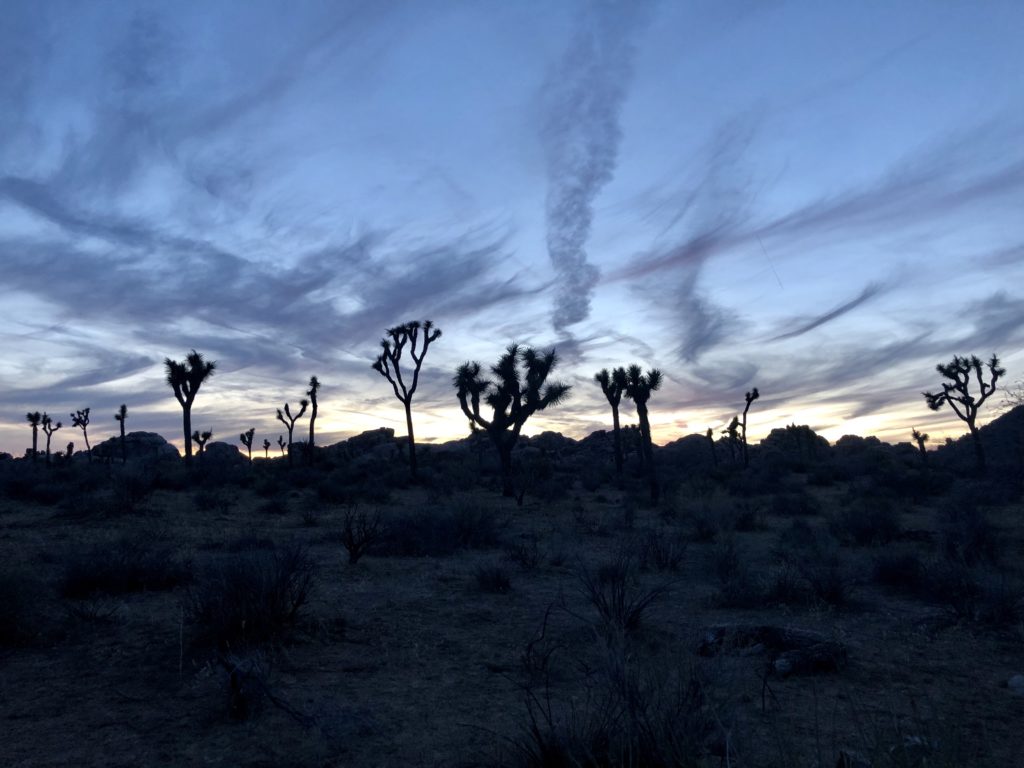

Joshua Tree National Park has it all—passionate staff, dragonfly larvae, and beautiful sunsets.
It is adventures like these that remind us why we love to do the work that we do. At the beginning of March, the Dragonfly Mercury Project(DMP) core team convened for the annual core team meeting, spending three days at Joshua Tree National Park preparing for the 2020 sampling season. The Joshua Tree meeting was the 5th core team meeting, held previously at Acadia National Park, Maine; Portland, Oregon; Saguaro National Park, Tucson, AZ; and virtually, coordinated via the National Park Service in Denver, Colorado. We hiked among the cholla and Joshua trees, found an oasis with dragonfly larvae in the Mojave Desert, and even managed to fit in bowling and karaoke at the end of the day. Over the past two years, I’ve been lucky enough to be drafted onto the DMP team and become intimately involved with the extensive coordination and management that this project requires. This collaboration between the National Park Service (NPS), U.S. Geological Survey (USGS), and now Appalachian Mountain Club (AMC – Conservation Research) is inspiring parks everywhere to engage citizen scientists in ground-breaking mercury research and monitoring.
Now entering its 10th field season, the DMP is focusing on growth and expansion. Our topics of conversation at the Joshua Tree retreat covered everything from finalizing a program vision and prospectus to engaging Tribal communities. The team discussed how we can utilize our resources to give back to the groups that participate in sampling and make it possible for us to generate mercury data. We developed ideas to engage new parks and citizen science groups, shorten the turnaround time for lab analysis results, and make our data more accessible to and exciting for the general public. We also identified areas for potential growth through educational programming, more interactive web content, and DMP promotion in the larger communities of mercury research and citizen science. It is our hope that resource managers can use these data to inform their policies, students can use DMP data in authentic science projects to practice making graphs and hypotheses, and the general public can find the data easy and exciting to explore.
The meeting wasn’t all coffee and brainstorming; we also had the opportunity to go out and sample dragonfly larvae in Joshua Tree! Park staff from the natural resources and media teams guided us through the Mojave Desert to collect samples from a park and region of the country that we have been striving to include in our dataset. Just our luck—we found an abundance of larvae at our very first site, making Joshua Tree the newest park to contribute samples to the DMP. We stumbled upon an oasis of palm trees and small ponds full of frogs, vegetation, and dragonfly larvae. Thanks to the park’s diligent protection of this oasis as a biologically sensitive area, we were able to collect samples that will provide baseline data for mercury in Joshua Tree, a beginning for longer-term monitoring in the park. These data will allow us to generate new information about mercury pollution and deposition in our nation’s western public lands.
While there is room for growth and expansion, the DMP team also took the time to acknowledge past accomplishments. The project has engaged over 100 parks and more than 4,500 citizen scientists in 47 of the 50 United States. Post-sampling feedback from parks has prompted us to improve sampling assistance, identification tools, and data generation and visualization. The transition from the University of Maine to the Appalachian Mountain Club (AMC) has allowed the DMP to keep developing its goals related to outreach, education, and citizen science. We have produced resources such as a sampling demonstration video, an interactive Dragonfly Mercury Data Map, and a detailed video on how to identify dragonfly larvae to family. With ongoing funding through main project partners the National Park Service, U.S. Geological Survey, and National Park Foundation; support from partners AMC and Schoodic Institute; and now deeper ties with Dartmouth College, the DMP can continue to develop these products for our invaluable parks and citizen scientists.
So, what can you expect from the DMP in the future? More data results! Interactive maps and storyboards! Photo contests! Facebook and Instagram updates! We love the work that we are able to do with this project, and we look forward to all the possibilities that our research has to offer. This unique study connects parks to citizen scientists and the local community and unites scientists and resource managers nationwide in the effort to investigate mercury as a pollutant. Our three days at Joshua Tree provided us with adventure, laughter, and lots—and lots—of tasks to act upon. We can’t wait to see which parks, old and new, join us for the 2020 sampling season. See you in the field!